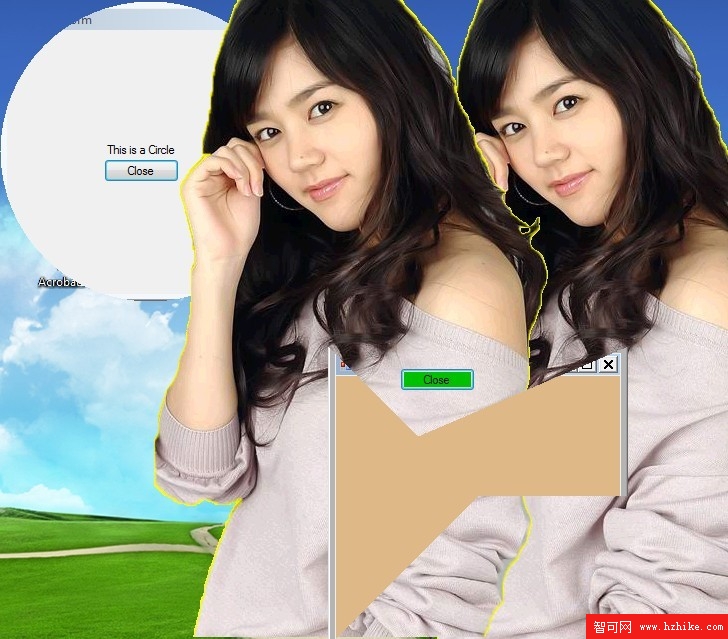現在,C#創建不規則窗體不是一件難事,下面總結一下:
一、自定義窗體
一般為規則的圖形,如圓、橢圓等。
做法:重寫Form1_Paint事件(Form1是窗體的名字),最簡單的一種情況如下:
- System.Drawing.Drawing2D.GraphicsPath shape = new System.Drawing.Drawing2D.GraphicsPath();
- shape.AddEllipse(0,0,this.Height, this.Width);
- this.Region = new Region(shape);
即重繪窗體的規則。
二、利用背景圖片實現
1. 設置窗體的背景圖片,其中背景圖片是24位(不包括24)以下的位圖(BMP圖片),並且要設置TansparencyKey的值,一般為你背景圖片的背景色,即創建不規則圖片時的底色,一般設為你圖片中沒有的顏色。
這種做法的不好的地方就是背景圖片一定要16位或者更低的,而且還要確保客戶端的顯示。如果監視器的顏色深度設置大於 24 位,則不管 TransparencyKey 屬性是如何設置的,窗體的非透明部分都會產生顯示問題。若要避免出現這種問題,請確保“顯示”控制面板中的監視器顏色深度的設置小於 24 位。當開發具有這種透明功能的應用程序時,請牢記應使您的用戶意識到此問題。
實現步驟如下:
1. 新建Windows application
2. 選擇窗體,找到BackgroundImage屬性,點擊打開新的窗口,選擇下面的導入資源文件,選擇你的不規則的BMP圖片
3. 找到窗體的TansparencyKey,將它設置為你背景圖片的背景色(如黃色)
4. 找到窗體的FormBorderStyle,將其設置為none,即不顯示標題欄
5. 運行
<!--[endif]-->
2. 跟背景圖片一樣的圖形,不過是動態加載,遍歷位圖以實現不規則窗體。它的原理是這樣的,在Form的load事件中寫方法使得窗體的描繪區域發生改變。
實現步驟如下:
1. 建立winform應用程序
2. 找到窗體的Load事件,雙擊進行編輯
3. 編寫方法,主要的代碼如下:
- class BitmapRegion
- {
- public BitmapRegion()
- { }
- /// <summary>
- /// Create and apply the region on the supplIEd control
- /// 創建支持位圖區域的控件(目前有button和form)
- /// </summary>
- /// <param name="control">The Control object to apply the region to控件</param>
- /// <param name="bitmap">The Bitmap object to create the region from位圖</param>
- public static void CreateControlRegion(Control control, Bitmap bitmap)
- {
- // Return if control and bitmap are null
- //判斷是否存在控件和位圖
- if (control == null || bitmap == null)
- return;
- // Set our control''s size to be the same as the bitmap
- //設置控件大小為位圖大小
- control.Width = bitmap.Width;
- control.Height = bitmap.Height;
- // Check if we are dealing with Form here
- //當控件是form時
- if (control is System.Windows.Forms.Form)
- {
- // Cast to a Form object
- //強制轉換為FORM
- Form form = (Form)control;
- // Set our form''s size to be a little larger that the bitmap just
- // in case the form''s border style is not set to none in the first place
- //當FORM的邊界FormBorderStyle不為NONE時,應將FORM的大小設置成比位圖大小稍大一點
- form.Width = control.Width;
- form.Height = control.Height;
- // No border
- //沒有邊界
- form.FormBorderStyle = FormBorderStyle.None;
- // Set bitmap as the background image
- //將位圖設置成窗體背景圖片
- form.BackgroundImage = bitmap;
- // Calculate the graphics path based on the bitmap supplIEd
- //計算位圖中不透明部分的邊界
- GraphicsPath graphicsPath = CalculateControlGraphicsPath(bitmap);
- // Apply new region
- //應用新的區域
- form.Region = new Region(graphicsPath);
- }
- // Check if we are dealing with Button here
- //當控件是button時
- else if (control is System.Windows.Forms.Button)
- {
- // Cast to a button object
- //強制轉換為 button
- Button button = (Button)control;
- // Do not show button text
- //不顯示button text
- button.Text = "";
- // Change cursor to hand when over button
- //改變 cursor的style
- button.Cursor = Cursors.Hand;
- // Set background image of button
- //設置button的背景圖片
- button.BackgroundImage = bitmap;
- // Calculate the graphics path based on the bitmap supplIEd
- //計算位圖中不透明部分的邊界
- GraphicsPath graphicsPath = CalculateControlGraphicsPath(bitmap);
- // Apply new region
- //應用新的區域
- button.Region = new Region(graphicsPath);
- }
- }
- /// <summary>
- /// Calculate the graphics path that representing the figure in the bitmap
- /// excluding the transparent color which is the top left pixel.
- /// //計算位圖中不透明部分的邊界
- /// </summary>
- /// <param name="bitmap">The Bitmap object to calculate our graphics path from</param>
- /// <returns>Calculated graphics path</returns>
- private static GraphicsPath CalculateControlGraphicsPath(Bitmap bitmap)
- {
- // Create GraphicsPath for our bitmap calculation
- //創建 GraphicsPath
- GraphicsPath graphicsPath = new GraphicsPath();
- // Use the top left pixel as our transparent color
- //使用左上角的一點的顏色作為我們透明色
- Color colorTransparent = bitmap.GetPixel(0, 0);
- // This is to store the column value where an opaque pixel is first found.
- // This value will determine where we start scanning for trailing opaque pixels.
- //第一個找到點的X
- int colOpaquePixel = 0;
- // Go through all rows (Y axis)
- // 偏歷所有行(Y方向)
- for (int row = 0; row < bitmap.Height; row++)
- {
- // Reset value
- //重設
- colOpaquePixel = 0;
- // Go through all columns (X axis)
- //偏歷所有列(X方向)
- for (int col = 0; col < bitmap.Width; col++)
- {
- // If this is an opaque pixel, mark it and search for anymore trailing behind
- //如果是不需要透明處理的點則標記,然後繼續偏歷
- if (bitmap.GetPixel(col, row) != colorTransparent)
- {
- // Opaque pixel found, mark current position
- //記錄當前
- colOpaquePixel = col;
- // Create another variable to set the current pixel position
- //建立新變量來記錄當前點
- int colNext = col;
- // Starting from current found opaque pixel, search for anymore opaque pixels
- // trailing behind, until a transparent pixel is found or minimum width is reached
- ///從找到的不透明點開始,繼續尋找不透明點,一直到找到或則達到圖片寬度
- for (colNext = colOpaquePixel; colNext < bitmap.Width; colNext++)
- if (bitmap.GetPixel(colNext, row) == colorTransparent)
- break;
- // Form a rectangle for line of opaque pixels found and add it to our graphics path
- //將不透明點加到graphics path
- graphicsPath.AddRectangle(new Rectangle(colOpaquePixel, row, colNext - colOpaquePixel, 1));
- // No need to scan the line of opaque pixels just found
- col = colNext;
- }
- }
- }
- // Return calculated graphics path
- return graphicsPath;
- }
- }
4. 運行
<!--[endif]-->
三、調用類庫實現
主要就是根據一些坐標,然後根據這些坐標繪制窗體
代碼如下:
- public Form3()
- {
- InitializeComponent();
- //創建不規則窗體
- POINTAPI[] poin;
- poin = new POINTAPI[5];
- poin[0].x = 90;
- poin[0].y = 90;
- poin[1].x = this.Width;
- poin[1].y = 0;
- poin[2].x = Width;
- poin[2].y = this.Height / 2;
- poin[3].x = Width / 2;
- poin[3].y = Height / 2;
- poin[4].x = 0;
- poin[4].y = Width;
- Boolean flag = true;
- IntPtr hRgn = CreatePolygonRgn(ref poin[0], 8, 1);
- SetWindowRgn(this.Handle, hRgn, ref flag);
- this.BackColor = Color.BurlyWood;
- }
- [StructLayout(LayoutKind.Sequential)]
- private struct POINTAPI
- {
- internal int x;
- internal int y;
- }
- [DllImport("gdi32.dll")]
- private static extern IntPtr CreatePolygonRgn(ref POINTAPI lpPoint,int nCount,int nPolyFillMode);
- [DllImport("user32.dll")]
- private static extern IntPtr SetWindowRgn(IntPtr hWnd,IntPtr hRgn, ref Boolean bRedraw);
- //設置窗體顯示狀態
- [DllImport("user32.dll")]
- private static extern int SetWindowPos(IntPtr hwnd,int hWndInsertAfter,int x,int y,int cx,int cy,int wFlags);
- private void Start_Btn_Click(object sender, EventArgs e)
- {//始終顯示在前面
- SetWindowPos(this.Handle, -1, 0, 0, 0, 0, 1);
- }
- private void button1_Click(object sender, EventArgs e)
- {
- //最小化始終顯示在前面
- SetWindowPos(this.Handle, -1, 0, 0, 0, 0, 0);
- }
當然,我們也可以自定義窗體的動作,如按著某個軌跡一定,下面的代碼中的BackgroundForm程序中就小試了一下,效果還不錯,下面是這些程序的效果圖(有點亂)和代碼:

代碼下載:http://files.cnblogs.com/alexis/IrregularForm.rar
代碼是.Net 2.0的,也可以轉換為其他版本的,只要運行主程序即可。
以上的四種方法有利也有弊,希望大家提意見或者更好的解決方案。
原文標題:C#創建不規則窗體的幾種方式
鏈接:http://www.cnblogs.com/alexis/archive/2010/08/29/1811826.Html
【編輯推薦】
【責任編輯:彭凡 TEL:(010)68476606】